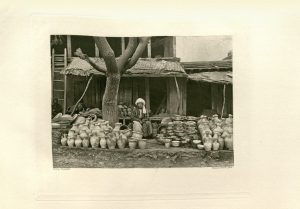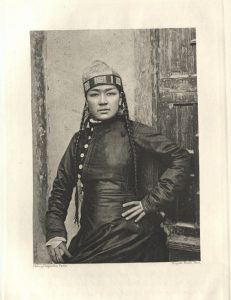By Zinaida Osipova
A Travers le Turkestan Russe (1902) is an illustrated book by a French photographer and traveler, Hugues Krafft (1853-1935). Inheriting his parents’ fortune in 1877 allowed him to embark on a world tour in 1881. Krafft, influenced by an elite education and the vogue of the time for “exotic” travel, could not skip the East during his voyage. He visited Asia and America and wrote a review of his travels in Souvenirs de Notre Tour du Monde (1886) illustrated by his photographs. Krafft was an amateur photographer, thought to be the first person to use an instantaneous camera in Japan.
In 1899, Krafft traveled to Turkestan, a region conquered by the Russian Empire in the second half of the nineteenth century and comprising the territory of what is now Turkmenistan, Uzbekistan, Tajikistan, Kyrgyzstan and parts of Kazakhstan. In 1902, Hachette et Cie published his account of the trip accompanied by 265 high-quality images depicting the life of local people. Krafft divided his book into several chapters, covering a range of topics, such as “ancient ruins of Samarkand”, “Muslim houses”, “numerous masculine and feminine portraits”, and the “great secular and religious festivals”.
Krafft started his narrative by describing “New Russian cities”, which were Russian settlements in the region. He noted that Russians stationed themselves outside of indigenous centers to avoid the “needless promiscuity with populations that are morally separated from them by fundamental differences in religion and costumes”.[2] “New Russian cities” were designed similarly to those in the “motherland” and contained various buildings: churches, banks, schools, hospitals. The separation of Russian and local quarters tells us that even though this area of Turkestan was territorially Russian, it was not Russian culturally.
Krafft provided an outline of Turkestan’s indigenous cities that featured bazaars and mosques in central quarters. The description of meandering roads, different types of bazaars, vivid colors and avenues of European style conveys a blend of original and novel styles that the region exhibited. Krafft pointed out that Bukhara was the only Muslim city that was mostly intact after the Russian conquest, incorporating photographs from the city in his narrative.
Krafft went beyond presenting his images and describing the status quo; he attempted to explain how things had been before and how they changed with the arrival of European style brought by Russian colonists. Eager to demonstrate the character of Turkestan, the author took the readers to Samarkand, one of the oldest Asian cities, with its grand monuments and history. The photograph of the door to the mosque of Shah-i-Zinda demonstrates Krafft’s dedication to details. His aspiration to convey the essence of the region pervaded the book in the form of charismatic images and thorough story accompanying them.
Following his approach throughout the book, he included extensive information on climate, agriculture, topography and local trades in the chapter on villages of Turkestan. The “Dwellings and Customs” chapter outlined structure and interiors of housing as well as traditions of sartes, or indigenous population. This chapter, along with the following one that was dedicated to costumes, contained many photographs capturing locals occupied with traditional activities, such as drinking tea, and wearing national attire. True to his informative style, Krafft elaborated on the composition and roots of the population of Turkestan. Numerous portraits of men and women show us that the author was trying to present an exhaustive compilation of regional diversity. He explained that he was able to take photographs of the female population by visiting and getting a permission from courtesan houses, which reminds us of the realities of Muslim world of the time.
The author concluded the book with a chapter on “Major Muslim Holidays”, at the end of which he expressed his regret about leaving and posed a question of whether “our [Western] material progress is as enviable as we think”.[3] The assumption that he made tells us that a man of Krafft’s origin and status would assume Western superiority to Eastern civilizations. Despite the remark, Krafft’s tone throughout the book remained descriptive, showing that the primary goal of the account was educational.
Written by a Frenchman, A Travers le Turkestan Russe, is a comprehensive review of the region that was exotic to Europeans. An array of high-quality photographs along with a detailed narrative based on a first-hand experience created an engaging story at the time when photography and traveling were still luxuries. The book received recognition from the Geographical Society of Paris and the French Academy, which attests to its influence at the time. Even though Krafft toured the world, he emphasized his experiences in the Asian region by publishing travel accounts about Japan and Turkestan. That speaks not only about his personal preferences but also about European curiosity about the area during his time.
The book is an informative historical source that lets us take a glimpse into what Russian Turkestan was at the turn of the century as well as see what a wealthy European traveler had to say about it. Since Krafft visited the region two decades after it had been conquered by Russia, the book provides some insight into associated changes that had occurred or were underway. Even though the images are in black and white, they are of superior quality and could be used as primary sources for research on Asian culture. A Travers le Turkestan Russe is an excellent source for learning more about, primarily, Turkestan, but could also be used as a supporting source for those interested in history of European travels as well as Russian conquests in Asia.
Zinaida Osipova is a first-year M.A. student in the History Department. This post is the first of several highlighting some of the rare books in Miami’s Special Collections and is supported by a GSSA Research Fellowship.









